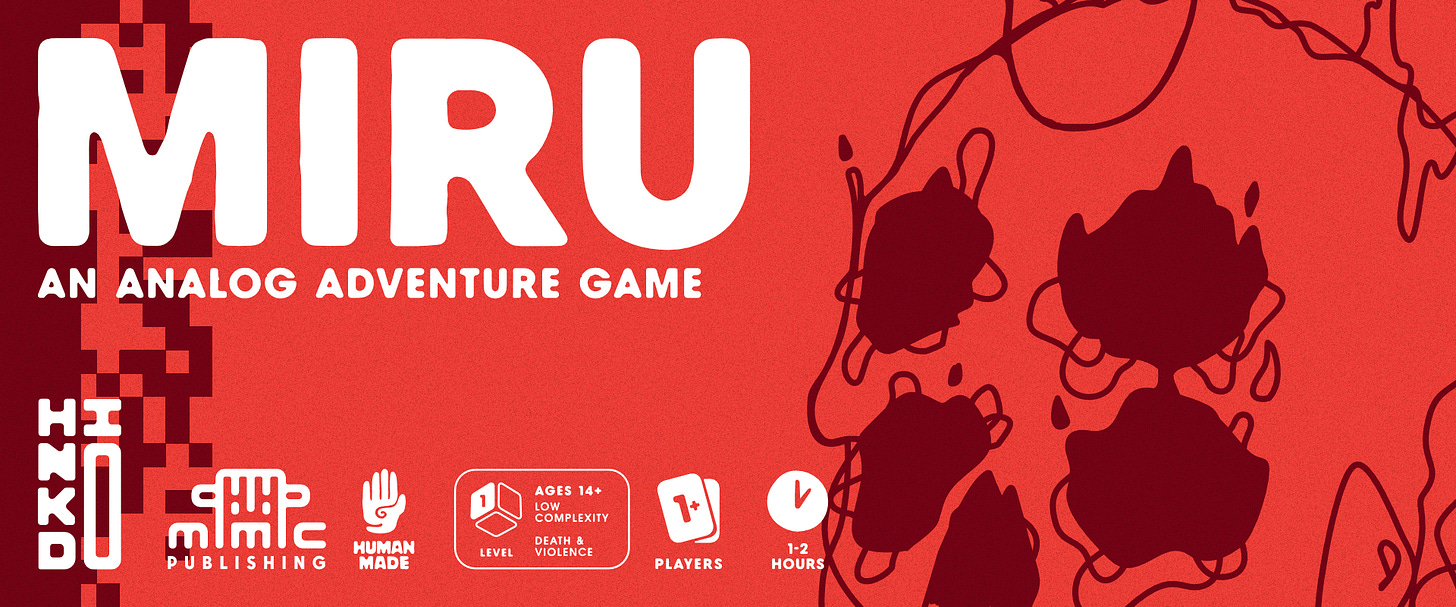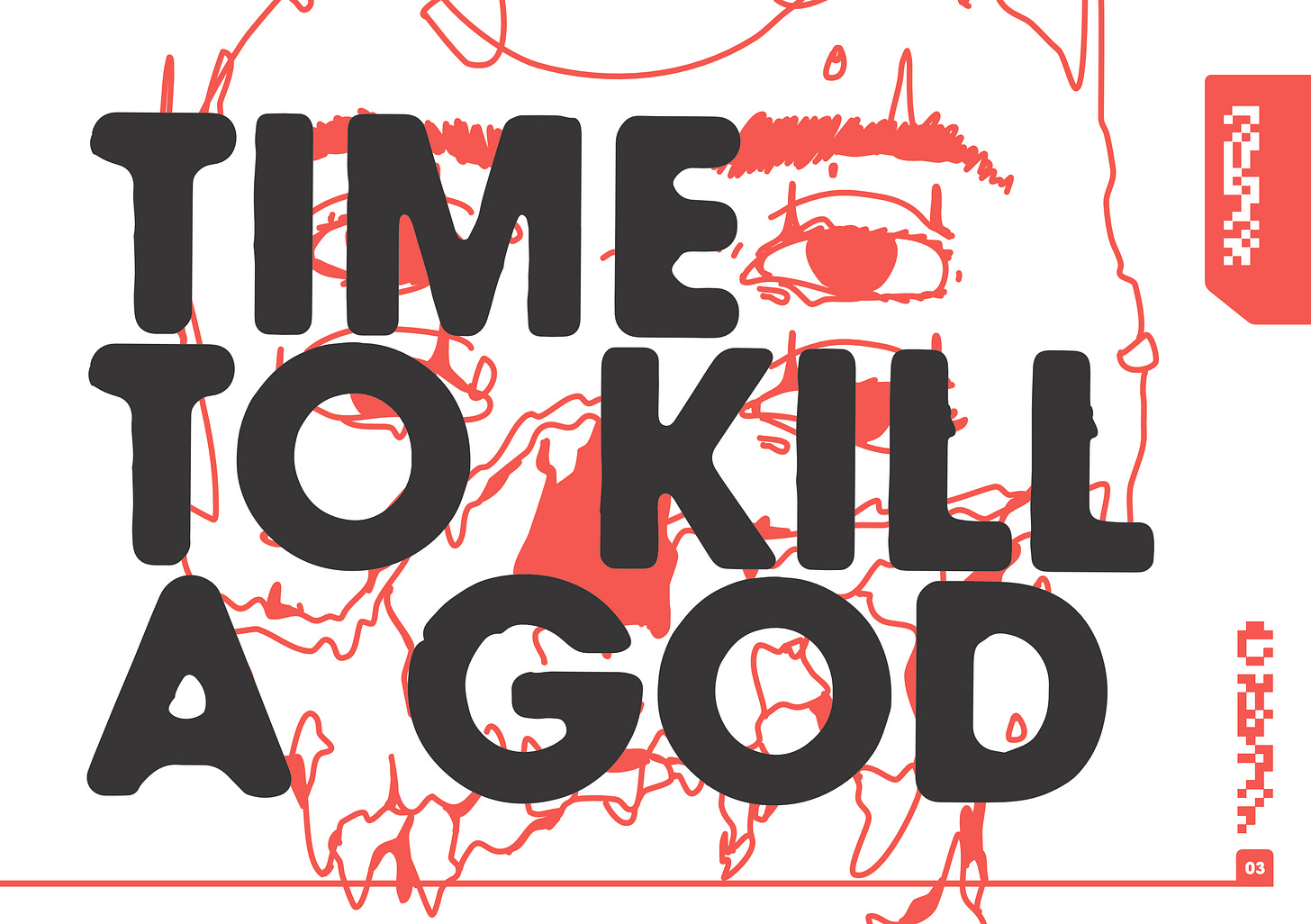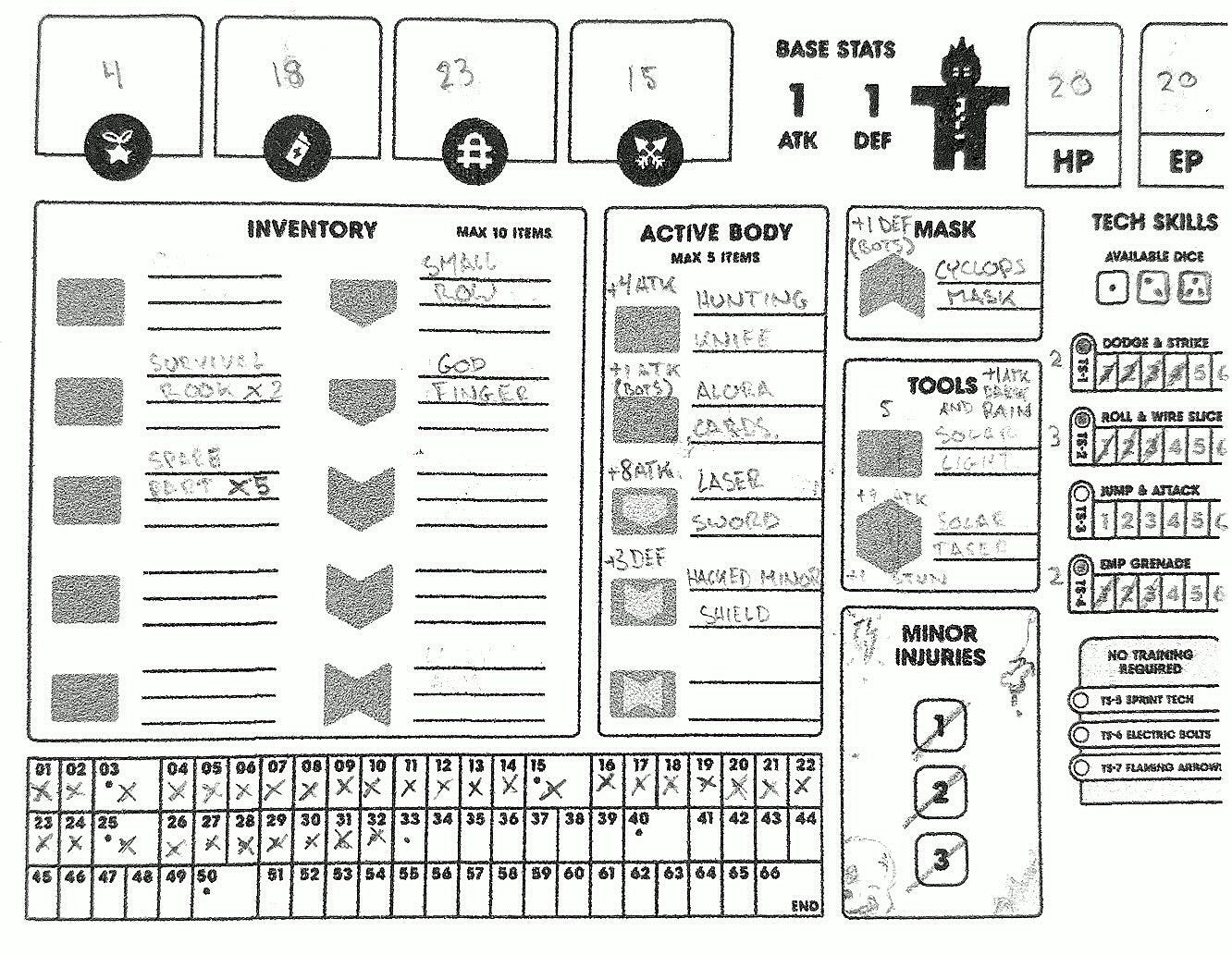MIRU is a solo hex crawl that drops players into the not-too-distant future of 2125 to seek vengeance against a robotic god in a world post-civilization.
To undertake the monumental task of godslaying, you’ll need only the zine, a writing instrument, 3d6 for rolling, and 2d20 for tracking Health and Energy. After its introductory prologue, MIRU immediately introduces the relatively simple game loop of an in-world Day.
MIRU’s Game Loop
The Day begins by rolling a d6 to determine the terrain of an unexplored hex, and then 2d6 determine an event to befall you.
Most commonly, you will stumble upon a ruin of the old world—gas stations, abandoned churches, dilapidated schools—where you might find any number of items to help you along your way. Occasionally, you’ll simply find text that peels back a small section of MIRU's lore.
Less commonly, you might find yourself in a combat encounter with the world's adversarial fauna or with a bot lurking the land. On much rarer occasions, you could happen upon larger, mapped areas and enter a simplified dungeon crawl, typically elongating the real-time length of your in-world Day.
Other times, villages will surface from dense forests or appear hidden among the swamps. Here, you can train Tech Skills to bolster yourself in combat, take on Quests to find Treasure, or trade gear in Bitliths—the currency of MIRU.
After experiencing an event, Dusk falls, and you have the opportunity to manage Health and Energy. Dark follows, and with it, hopefully rest. Dawn breaks soon after, bringing the only time to manage inventory and prepare for another Day seeking The God.
Each Day in MIRU feels distinct—a new terrain, a new event, a new encounter, new items. I often found myself reaching for the dice again, compelled to start another Day as the last one ended.
Mapping MIRU: A Solo Hex Crawl
MIRU's game book includes a blank hex map for marking details of progress (or setback) at the end of the Day—small depictions of your findings on each outing. HINOKODO even includes a short section with suggestions for drawing terrain and icons to note special circumstances or landmarks. Over the course of the game, this map becomes a relic of your time wandering MIRU's fallen world and a record of the game in itself in lieu of an optional journal.
I’m certainly no visual artist, but in my own game of MIRU, drawing the hex map at the end of each Day became one of my favorite parts of the experience.
HINOKODO’s Mimic Publishing also has a Hex Kit for pre-order that looks like it could be an interesting product for those who want a more traditional solo boardgame experience from MIRU. Applicable events for players using the Hex Kit are denoted in the rules with a special red hexagon icon, and the kit appears to be compatible with MIRU’s successors, too.
Close Encounters
Whether you’re face-to-face with a Buster Bot or cornered by a Grolar Bear, the dangers of the world you wander are real and present. Even from your first combat encounter, MIRU makes it clear that it will not pull any punches, and you need to do all that you can to gather a well-rounded inventory. This not only includes arming yourself and equipping defensive gear, but also scavenging meal bars and fruit—analogous to potions for recovering Health and Energy.
There were times when MIRU had me sweating—my life on the brink and only pulling through with a lucky, tumbling d6. I faced my share of unlucky rolls as well, whittling my HP to low single-digits and forcing me to gorge myself on meal bars at the Day’s end. This rarely felt unfair, though, and my misfortunes were usually brought upon myself by being overly conservative with my expendable items. Experiencing hunger early on in the game also meant that I would usually take healing meal bars for the rest of my time with the game when given the choice on a loot table.
While the actual combat in MIRU mostly boils down to exchanging dice rolls and hoping you’ve got enough ATK and DEF modifiers to come through the other side, there are a few tactical choices available. These come in the form of Tech Skills, which offer varying degrees of help in battle for spent Energy (EP). Training these Skills in Villages also bolsters their effectiveness in battle by adding more dice to the pool for success.
Unfolding the Story In MIRU
One of the most interesting things I found in MIRU was the mechanic of Cutscenes. Every day at Dawn, the first thing you will do is to mark a Day on your calendar. Like a prisoner etching tallies into the cell wall, these marks track the length of time spent in-game, but your calendar also acts as one long countdown clock.
Whether you face The God and the game reaches its natural end or you force endgame by running down the 66-Day limit, you’ll experience interspersed Cutscenes along the way. When reaching a Day on the calendar with a pre-marked dot, you’ll forgo the usual Day cycle to take part in an established event.
The first Cutscene begins:
As you're walking through a dark and thick part of the forest, you find a glass skyscraper. You approach the entrance and look up to admire how endlessly tall it is. Inside, the lobby is filled with broken glass and forest debris.
In these first lines and the remainder of the Day 3 Cutscene, MIRU shows its desolate world and the meaninglessness of its fallen civilization. The writing in the scenes MIRU offers is usually concise, but evocative—easily conjuring the image for the player and pulling them through the narrative.
Many of the events that I stumbled on during play have stayed with me, and I won’t spoil it, but if you come across a black obelisk on your journey, welcome its gift, but prepare for just a bit of heartbreak.
A First for Solo Roleplaying
Solo roleplaying seems to be an emerging niche in the hobby of tabletop roleplaying games, but the relative novelty means many of those who are new to unguided play often have a difficult time finding out where to start—evidenced by frequent forum posts requesting suggestions for first games or tips for going solo.
MIRU is a solo-first game, but due to its procedural rules, established storyline, and lack of character creation, it might be on the outskirts of what many might consider a solo roleplaying game. The game’s creator doesn’t refer to it as a “solo RPG,” but instead an “Analog Adventure,” still summoning related images of dice, pen, and paper. Even though the character sheet doesn’t even have a space to name your PC, other roleplaying elements like inventory management, combat, and areas of true player agency give MIRU more than a tinge of RPG flavor. Its situation in the twilight between these two worlds makes MIRU a great first foray into unguided, solitary play, and that’s what it was for me—an excellent medium to just jump in.
Though MIRU does have a degree of replayability in its randomized locations and encounters, the narrative that emerges will mostly be the same in subsequent plays. Even so, it might be worth revisiting after some time just to experience more of the events HINOKODO provides that were missed the first time around.
At $5, the MIRU PDF was absolutely worth my solitary time, despite the occasional typo or ambiguity in some rulings. I really like this game, and I think a lot of people looking to wade into solo RPGs will find a lot to enjoy here, too—given they aren’t solely drawn to journaling mechanics like those found in Thousand Year Old Vampire and Alone Among the Stars.
More MIRU
If you want to learn a bit more about MIRU,
—creator of RUNE (another game on the line of solo boardgame and solo TTRPG)—has a video further explaining MIRU in just 5 minutes.For those who enjoy what MIRU offers, HINOKODO has also published MIRU II: An Analog Horror Game, and MIRU III is on pre-order at the time of writing this review.









